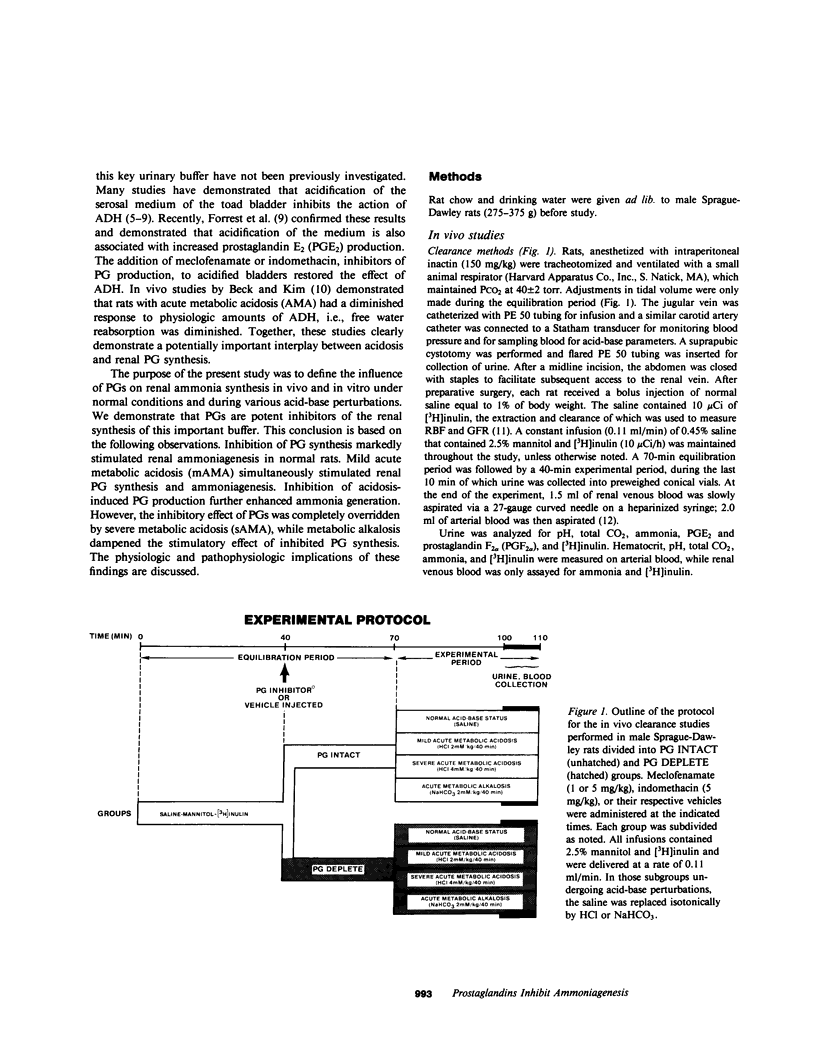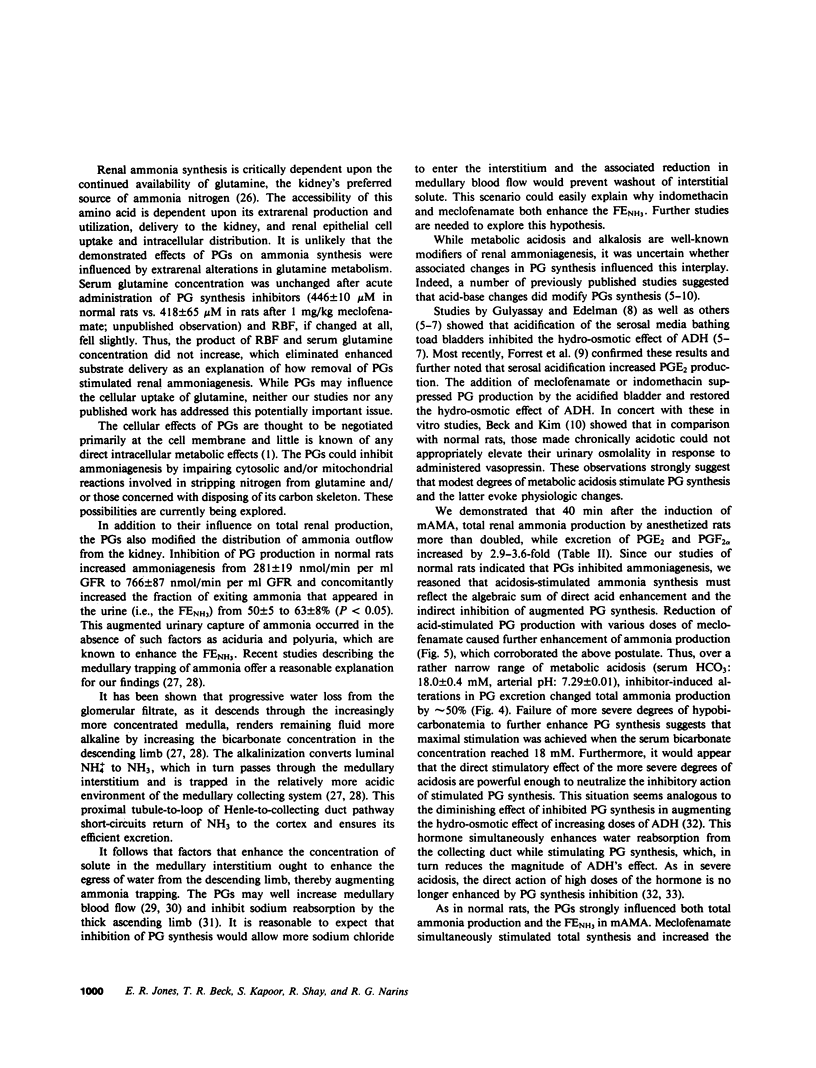Abstract
We describe the inhibitory effect of prostaglandins (PGs) on in vivo rat renal ammonia synthesis. The influence of systemic pH upon urinary PG excretion and ammoniagenesis was also investigated. Finally, PG production by incubated rat renal cortical slices was suppressed to investigate the PG-ammonia interplay in the absence of changes in renal blood flow, glomerular filtration rate, ambient electrolyte concentrations or extrarenal hormonal factors. In vivo ammonia synthesis doubled and PG excretion fell by 44% in normal rats, after intravenous administration of 1 mg/kg of meclofenamate. Higher doses of meclofenamate further augmented ammonia production and further reduced PG excretion. PG depletion was also associated with an increase in fractional excretion of ammonia (FENH3) that was independent of changes in urine flow rate or pH. Acute metabolic acidosis (AMA) increased total ammonia synthesis but also stimulated PG production. Administration of meclofenamate to rats with mild AMA markedly reduced urinary PG excretion, further augmented ammonia synthesis, and significantly increased the FENH3. Inhibition of stimulated PG synthesis during severe AMA did not increase ammoniagenesis or FENH3. Acute metabolic alkalosis did not alter production of PGs or ammonia, but reduced the FENH3 by 42%. Meclofenamate nearly normalized the FENH3 but stimulated synthesis to a lesser degree than was seen in nonalkalotic rats that received meclofenamate. Inhibition of PG synthesis in incubated rat renal cortical slices also stimulated ammoniagenesis. Conversely, stimulation of PG synthesis decreased ammonia production and acidification of the incubation medium increased prostaglandin F2 alpha production. Thus, in vitro findings support the in vivo results. We conclude that PGs inhibit ammonia synthesis in normal rats and in those undergoing mild AMA. Severe acidosis overrides this inhibitory effect of PGs, whereas metabolic alkalosis suppresses the stimulatory effect of PG synthesis inhibition.
Full text
PDF










Images in this article
Selected References
These references are in PubMed. This may not be the complete list of references from this article.
- Aiken J. W., Vane J. R. Intrarenal prostaglandin release attenuates the renal vasoconstrictor activity of angiotensin. J Pharmacol Exp Ther. 1973 Mar;184(3):678–687. [PubMed] [Google Scholar]
- BENTLEY P. J. The effects of neurohypophysial extracts on the water transfer across the wall of the isolated urinary bladder of the toad Bufo marinus. J Endocrinol. 1958 Sep;17(3):201–209. doi: 10.1677/joe.0.0170201. [DOI] [PubMed] [Google Scholar]
- Beck N., Kim H-P Effect of acute metabolic acidosis on vasopressin-dependent cyclic AMP in rat kidney. Endocrinology. 1975 Jun;96(6):1552–1558. doi: 10.1210/endo-96-6-1552. [DOI] [PubMed] [Google Scholar]
- Beck T. R., Hassid A., Dunn M. J. Desamino-D-Arginine vasopressin induces fatty acid cyclooxygenase activity in the renal medulla of diabetes insipidus rats. J Pharmacol Exp Ther. 1982 May;221(2):269–274. [PubMed] [Google Scholar]
- Berl T., Raz A., Wald H., Horowitz J., Czaczkes W. Prostaglandin synthesis inhibition and the action of vasopressin: studies in man and rat. Am J Physiol. 1977 Jun;232(6):F529–F537. doi: 10.1152/ajprenal.1977.232.6.F529. [DOI] [PubMed] [Google Scholar]
- Berl T., Schrier R. W. Mechanism of effect of prostaglandin E 1 on renal water excretion. J Clin Invest. 1973 Feb;52(2):463–471. doi: 10.1172/JCI107203. [DOI] [PMC free article] [PubMed] [Google Scholar]
- Buerkert J., Martin D., Trigg D. Ammonium handling by superficial and juxtamedullary nephrons in the rat. Evidence for an ammonia shunt between the loop of Henle and the collecting duct. J Clin Invest. 1982 Jul;70(1):1–12. doi: 10.1172/JCI110581. [DOI] [PMC free article] [PubMed] [Google Scholar]
- Culpepper R. M., Andreoli T. E. Interactions among prostaglandin E2, antidiuretic hormone, and cyclic adenosine monophosphate in modulating Cl- absorption in single mouse medullary thick ascending limbs of Henle. J Clin Invest. 1983 Jun;71(6):1588–1601. doi: 10.1172/JCI110915. [DOI] [PMC free article] [PubMed] [Google Scholar]
- Forrest J. N., Jr, Schneider C. J., Goodman D. B. Role of prostaglandin E2 in mediating the effects of pH on the hydroosmotic response to vasopressin in the toad urinary bladder. J Clin Invest. 1982 Mar;69(3):499–506. doi: 10.1172/JCI110475. [DOI] [PMC free article] [PubMed] [Google Scholar]
- Gulyassy P. F., Edelman I. S. Hydrogen-ion dependence of the antidiuretic action of vasopressin, oxytocin and deaminooxytocin. Biochim Biophys Acta. 1965 May 25;102(1):185–197. doi: 10.1016/0926-6585(65)90212-8. [DOI] [PubMed] [Google Scholar]
- HEINEMANN H. O. REVERSIBLE DEFECT IN RENAL AMMONIUM EXCRETION IN PATIENTS WITH HYPERCALCEMIA. Metabolism. 1963 Sep;12:792–803. [PubMed] [Google Scholar]
- Kaufman J. M., Siegel N. J., Hayslett J. P. Functional and hemodynamic adaptation to progressive renal ablation. Circ Res. 1975 Feb;36(2):286–293. doi: 10.1161/01.res.36.2.286. [DOI] [PubMed] [Google Scholar]
- Kurahasi K., Ishihara A., Uehara H. Determination of ammonia in blood plasma by an ion exchange method. Clin Chim Acta. 1972 Nov;42(1):141–146. doi: 10.1016/0009-8981(72)90387-7. [DOI] [PubMed] [Google Scholar]
- Larsson C., Anggård E. Increased juxtamedullary blood flow on stimulation of intrarenal prostaglandin biosynthesis. Eur J Pharmacol. 1974 Mar;25(3):326–334. doi: 10.1016/0014-2999(74)90263-5. [DOI] [PubMed] [Google Scholar]
- Lemieux G., Vinay P., Cartier P. Renal hemodynamics and ammoniagenesis. Characteristics of the antiluminal site for glutamine extraction. J Clin Invest. 1974 Mar;53(3):884–894. doi: 10.1172/JCI107629. [DOI] [PMC free article] [PubMed] [Google Scholar]
- Lifschitz M. D. Prostaglandins and renal blood flow: in vivo studies. Kidney Int. 1981 Jun;19(6):781–785. doi: 10.1038/ki.1981.80. [DOI] [PubMed] [Google Scholar]
- Mitnick P., Greenberg A., Coffman T., Kelepouris E., Wolf C. J., Goldfarb S. Effects of two models of hypercalcemia on renal acid base metabolism. Kidney Int. 1982 Apr;21(4):613–620. doi: 10.1038/ki.1982.68. [DOI] [PubMed] [Google Scholar]
- Narins R. G., Emmett M., Rascoff J., Jones E. R., Relman A. S. Effects of acute acid-base changes on in vivo total ammonia synthesis in the rat. Contrib Nephrol. 1982;31:47–52. doi: 10.1159/000406615. [DOI] [PubMed] [Google Scholar]
- Narins R. G., Relman A. S. Acute effects of acidosis on ammoniagenic pathways in the kidneys of the intact rat. Am J Physiol. 1974 Oct;227(4):946–949. doi: 10.1152/ajplegacy.1974.227.4.946. [DOI] [PubMed] [Google Scholar]
- Negus P., Tannen R. L., Dunn M. J. Indomethacin potentiates the vasoconstrictor actions of angiotensin II in normal man. Prostaglandins. 1976 Aug;12(2):175–180. doi: 10.1016/0090-6980(76)90111-8. [DOI] [PubMed] [Google Scholar]
- ORLOFF J., HANDLER J. S. The similarity of effects of vasopressin, adenosine-3',5'-phosphate (cyclic AMP) and theophylline on the toad bladder. J Clin Invest. 1962 Apr;41:702–709. doi: 10.1172/JCI104528. [DOI] [PMC free article] [PubMed] [Google Scholar]
- RICHET G., ARDAILLOU R., AMIEL C., LECESTRE M. ACIDIFICATION DE L'URINE PAR INJECTION INTRAVEINEUSE DE SELS DE CALCIUM. J Urol Nephrol (Paris) 1963 Jul-Aug;69:373–398. [PubMed] [Google Scholar]
- Rasmussen H., Schwartz I. L., Schoessler M. A., Hochster G. STUDIES ON THE MECHANISM OF ACTION OF VASOPRESSIN. Proc Natl Acad Sci U S A. 1960 Oct;46(10):1278–1287. doi: 10.1073/pnas.46.10.1278. [DOI] [PMC free article] [PubMed] [Google Scholar]
- Roman R. J., Kauker M. L. Renal effect of prostaglandin synthetase inhibition in rats: micropuncture studies. Am J Physiol. 1978 Aug;235(2):F111–F118. doi: 10.1152/ajprenal.1978.235.2.F111. [DOI] [PubMed] [Google Scholar]
- Sajo I. M., Goldstein M. B., Sonnenberg H., Stinebaugh B. J., Wilson D. R., Halperin M. L. Sites of ammonia addition to tubular fluid in rats with chronic metabolic acidosis. Kidney Int. 1981 Sep;20(3):353–358. doi: 10.1038/ki.1981.146. [DOI] [PubMed] [Google Scholar]
- Schlondorff D., Carvounis C. P., Jacoby M., Satriano J. A., Levine S. D. Multiple sites for interaction of prostaglandin and vasopressin in toad urinary bladder. Am J Physiol. 1981 Dec;241(6):F625–F631. doi: 10.1152/ajprenal.1981.241.6.F625. [DOI] [PubMed] [Google Scholar]
- Stokes J. B. Effect of prostaglandin E2 on chloride transport across the rabbit thick ascending limb of Henle. Selective inhibitions of the medullary portion. J Clin Invest. 1979 Aug;64(2):495–502. doi: 10.1172/JCI109487. [DOI] [PMC free article] [PubMed] [Google Scholar]
- Tannen R. L. Ammonia metabolism. Am J Physiol. 1978 Oct;235(4):F265–F277. doi: 10.1152/ajprenal.1978.235.4.F265. [DOI] [PubMed] [Google Scholar]
- Zenser T. V., Davis B. B. Effects of calcium on prostaglandin E2 synthesis by rat inner medullary slices. Am J Physiol. 1978 Sep;235(3):F213–F218. doi: 10.1152/ajprenal.1978.235.3.F213. [DOI] [PubMed] [Google Scholar]




